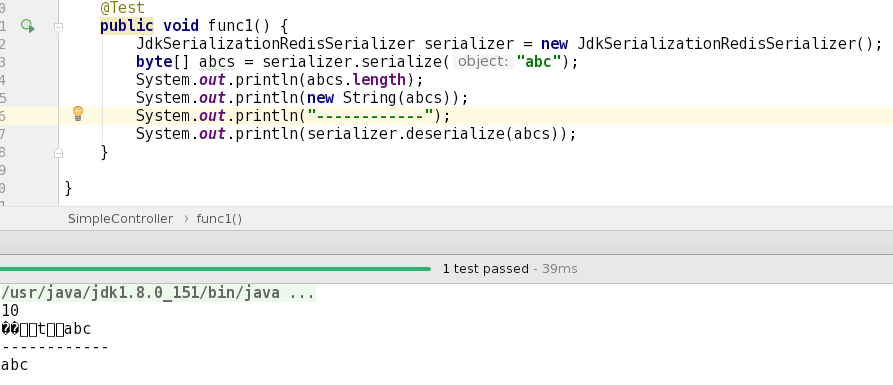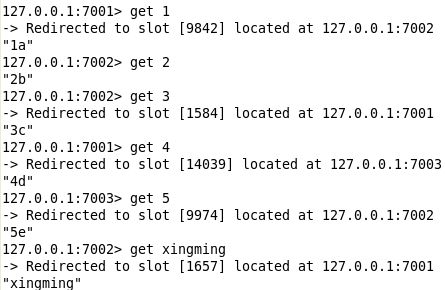前言 前面redis弄了那麼多, 就是為了在項目中使用. 那這裡, 就分別來看一下, 單機版和集群版在springboot中的使用吧. 在裡面, 我會同時貼出Jedis版, 作為比較. 單機版 1. pom.xml 2. application.yml 這裡為redis設置了一個密碼, 可以在 re ...
前言
前面redis弄了那麼多, 就是為了在項目中使用.
那這裡, 就分別來看一下, 單機版和集群版在springboot中的使用吧. 在裡面, 我會同時貼出Jedis版, 作為比較.
單機版
1. pom.xml
<!-- https://mvnrepository.com/artifact/org.springframework.boot/spring-boot-starter-data-redis --> <dependency> <groupId>org.springframework.boot</groupId> <artifactId>spring-boot-starter-data-redis</artifactId> <version>1.5.9.RELEASE</version> </dependency>
2. application.yml
spring:
redis:
port: 6379
host: 127.0.0.1
password: redis
這裡為redis設置了一個密碼, 可以在 redis.conf 文件中設置: requirepass 密碼
3. controller
@RestController @RequestMapping("simple") public class SimpleController { @Autowired private StringRedisTemplate stringRedisTemplate; @GetMapping("set") public void set(){ ValueOperations<String, String> operations = stringRedisTemplate.opsForValue(); operations.set("1", "1a"); operations.set("2", "2b"); operations.set("3", "3c"); operations.set("4", "4d"); operations.set("5", "5e"); operations.set("elvin", "elvin"); operations.set("abc", "abc"); operations.set("xingming", "xingming"); } }
4. Jedis
來看一下單機版redis下, Jedis是怎麼玩的.
@Test public void testJedisPool() throws Exception { // 第一步:創建一個JedisPool對象。需要指定服務端的ip及埠。 JedisPool jedisPool = new JedisPool("127.0.0.1", 6379); // 第二步:從JedisPool中獲得Jedis對象。 Jedis jedis = jedisPool.getResource(); jedis.auth("redis"); // 第三步:使用Jedis操作redis伺服器。 String result = jedis.get("abc"); System.out.println(result); // 第四步:操作完畢後關閉jedis對象,連接池回收資源。 jedis.close(); // 第五步:關閉JedisPool對象。 jedisPool.close(); }
結果我就不展示了, 通過以上步驟, 能把controller存入的數據, 讀取出來.
這裡有一點要註意以下, 如果步驟3用的不是StringRedisTemplate, 而是RedisTemplate, 那麼通過步驟4是讀取不出來的.
如果你裝了 redis desktop manager , 可以使用這個去看一下, 就會知道為啥讀不出來.
具體為啥會產生這樣的情況呢?
可以看一下RedisTemplate的源碼:

看得出來, 這裡使用了 JdkSerializationRedisSerializer 來序列化 key 和 value.
直觀點的話, 可以看下圖:

so, 這裡就能看出來, 為啥用abc直接去查, 是查不到想要的結果的.
集群版
在集群裡面, 如果你使用的是 spring-boot-starter-data-redis 的話, 就會發現, 超方便, 只要改一下配置文件就可以了, 其他的都可以不改.
1. application.yml
spring: redis: cluster: nodes: - 127.0.0.1:7001 - 127.0.0.1:7002 - 127.0.0.1:7003 - 127.0.0.1:7004 - 127.0.0.1:7005 - 127.0.0.1:7006 password: 123456
在application裡面配置集群節點.
2. controller
controller裡面的方法不變, 還是用那個. 直接用 Terminal 操作查看:

確實存進去了.
3. Jedis
@Test public void testJedisCluster() throws Exception { // 第一步:使用JedisCluster對象。需要一個Set<HostAndPort>參數。Redis節點的列表。 Set<HostAndPort> nodes = new HashSet<>(); nodes.add(new HostAndPort("127.0.0.1", 7001)); nodes.add(new HostAndPort("127.0.0.1", 7002)); nodes.add(new HostAndPort("127.0.0.1", 7003)); nodes.add(new HostAndPort("127.0.0.1", 7004)); nodes.add(new HostAndPort("127.0.0.1", 7005)); nodes.add(new HostAndPort("127.0.0.1", 7006)); JedisCluster jedisCluster = new JedisCluster(nodes, 2000, 5, 8, "123456", new GenericObjectPoolConfig()); // 第二步:直接使用JedisCluster對象操作redis。在系統中單例存在。 String result = jedisCluster.get("abc"); // 第三步:列印結果 System.out.println(result); // 第四步:系統關閉前,關閉JedisCluster對象。 jedisCluster.close(); }
這裡有個比較蛋疼的事情就是, 如果集群設置了密碼, 並不能通過jedisCluster.auth()方式來輸入密碼

剛開始, 我還以為這是不推薦使用的, 誰知道, 這tm是不能用啊. 過分了, 簡直.
通過Jedis的代碼, 可以發現, 單機版和集群版, 操作的對象是不一樣的, 那麼在開發的過程中, 怎麼來統一呢?(開發的時候, 不需要使用redis集群, 上線的時候, 直接切換過去就可以了)
那麼想要解決這個問題, 可以通過策略模式來解決, 定義一個操作介面, 在介面中定義方法, 我管你單機還是集群, 都要來實現這個介面. 那麼在操作的過程中, 就統一到介面了. 剩下來的就是賦值和切換了.
而使用 spring-boot-starter-data-redis 就不需要考慮那麼多了, 確實方便許多.


